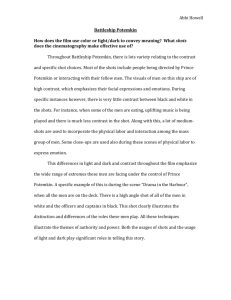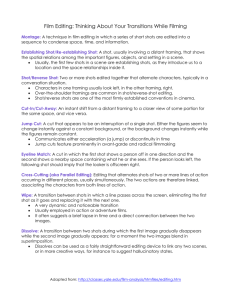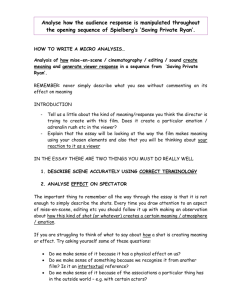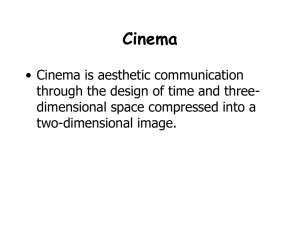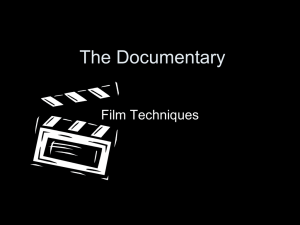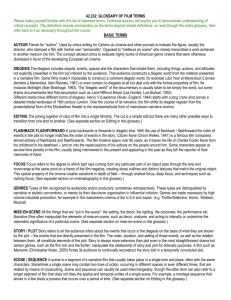Editing, Mise en Scene
advertisement
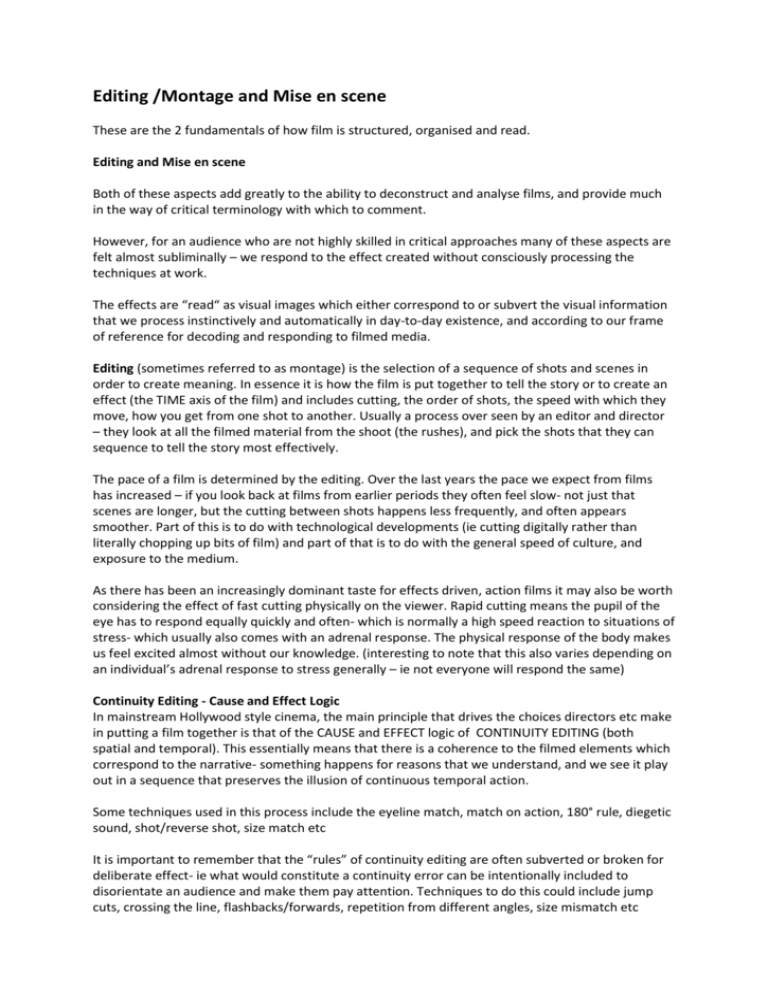
Editing /Montage and Mise en scene These are the 2 fundamentals of how film is structured, organised and read. Editing and Mise en scene Both of these aspects add greatly to the ability to deconstruct and analyse films, and provide much in the way of critical terminology with which to comment. However, for an audience who are not highly skilled in critical approaches many of these aspects are felt almost subliminally – we respond to the effect created without consciously processing the techniques at work. The effects are “read“ as visual images which either correspond to or subvert the visual information that we process instinctively and automatically in day-to-day existence, and according to our frame of reference for decoding and responding to filmed media. Editing (sometimes referred to as montage) is the selection of a sequence of shots and scenes in order to create meaning. In essence it is how the film is put together to tell the story or to create an effect (the TIME axis of the film) and includes cutting, the order of shots, the speed with which they move, how you get from one shot to another. Usually a process over seen by an editor and director – they look at all the filmed material from the shoot (the rushes), and pick the shots that they can sequence to tell the story most effectively. The pace of a film is determined by the editing. Over the last years the pace we expect from films has increased – if you look back at films from earlier periods they often feel slow- not just that scenes are longer, but the cutting between shots happens less frequently, and often appears smoother. Part of this is to do with technological developments (ie cutting digitally rather than literally chopping up bits of film) and part of that is to do with the general speed of culture, and exposure to the medium. As there has been an increasingly dominant taste for effects driven, action films it may also be worth considering the effect of fast cutting physically on the viewer. Rapid cutting means the pupil of the eye has to respond equally quickly and often- which is normally a high speed reaction to situations of stress- which usually also comes with an adrenal response. The physical response of the body makes us feel excited almost without our knowledge. (interesting to note that this also varies depending on an individual’s adrenal response to stress generally – ie not everyone will respond the same) Continuity Editing - Cause and Effect Logic In mainstream Hollywood style cinema, the main principle that drives the choices directors etc make in putting a film together is that of the CAUSE and EFFECT logic of CONTINUITY EDITING (both spatial and temporal). This essentially means that there is a coherence to the filmed elements which correspond to the narrative- something happens for reasons that we understand, and we see it play out in a sequence that preserves the illusion of continuous temporal action. Some techniques used in this process include the eyeline match, match on action, 180° rule, diegetic sound, shot/reverse shot, size match etc It is important to remember that the “rules” of continuity editing are often subverted or broken for deliberate effect- ie what would constitute a continuity error can be intentionally included to disorientate an audience and make them pay attention. Techniques to do this could include jump cuts, crossing the line, flashbacks/forwards, repetition from different angles, size mismatch etc It is also important to remember that the logic of a DIEGESIS can be different to the logic of reality. Often the way that unusual worlds are created in film (eg Inception) is by referencing CONTINUITY EDITING techniques which create the illusion of reality – however bizarre. Classic “Hollywood” styles can differ greatly to other film makers approaches around the world – for example Soviet Montage where the connections between shots are SYMBOLIC rather than based on a logic of cause and effect. (or consider the opening sequence to Melancholia) Mise en scene (or sometimes mise en shot)refers to everything that is put into a specific frame/shot for the camera (and the audience) to “see” (the SPACE axis of the film). This includes set, costumes, lighting, props; but also focus, shot selection, camera movement etc. It is the distillation of the work of all the production/creative team- ie no one person is solely in charge of the mise en scene. Often the acting is included in this for critical purposes, but within this unit we will consider it separately. The cinematographer/y frames the content, and decides what part of the space axis is significant in terms of communicating meaning to the viewer – and the content itself also carries meaning through design choices, casting, acting performance etc It’s quite possible to subvert expected visual relations within the shot/scene, so actually what appears in the frame bears no actual resemblance to what the crew present on the set see- for example using forced perspective, manipulating size and height, cheating reflections, removing walls. These are then reconciled within the editing process. (eg Lord of the Rings- using a combination of ditches, forced perspective and different sized body doubles or stilts in order to ensure that difference in size between hobbit and Gandalf is consistent, clear and obvious and that this can be sustained in close up, 2 shots, as well as long and group shots) If you consider the shot as being essentially a picture, that can be considered in terms of image analysis, then there are also visual habits that affect our ability to decode it. Certain positions in that space are more dominant than others (central or top portions), we will prioritise/ sequence information coming from the left because we (western Europeans) read from the left to the right. This also means that often it feels more truthful for a character who is ‘looking forward’ or finding a ‘bigger picture’ in terms of scene content to look to the right, and one who is reflecting on something in the past / regretting something to look to the left – and for this to be matched by corresponding camera moves and eyeline match cutting. This is also to do with the different roles the right and left hemispheres in the brain play. These visual habits we have can also be played around with and subverted to create additional layers of meaning eg the angel shot of Bruce Willis being shot in Sixth Sense reads as a he’s dead shot, but the Bruce Willis factor means we override that and invest in him being alive for the balance of the film, until the reveal at the end. Narrative and Shots/Sequences The shot selection also has an underlying capacity to reinforce aspects of character and narrative, over and above how the sequence is edited together. Close ups, long shots, establishing shots etc bring the audience into a varying closeness with the character in the shot, with different levels of intimacy. You would be unlikely to see a tearful emotional confession in a long shot. The scope of a battle would not be communicated solely by a close up. Differing shots build up a more complex, detailed picture which can offer more complex and subtle information. POV, shot/reverse shot, reaction shots etc can all prioritise one character over another, refining the focalisation of the narrative. If we see one character’s perspective over another – ie the camera matches their subjective experience- they will seem more significant than a character who is only the object of a shot. The audience can experience the film from a character’s perspective(restricted) (we discover as they discover), the camera shows us their point of view and this can create MYSTERY – as we do not know what we will see until they do. Or the audience can experience the film from the director’s / or an external perspective(omniscient), the camera shows us all the elements and characters, while the characters cannot see everything (dramatic irony) – and this can create SUSPENSE as we wait to see how and what they will find out. Really fast cut sequences might create a sense of urgency – but also can be upbeat. Slow, lingering sequences might be emotional and gentle- or they could be drawn out and suspenseful. The camera movement also contributes to the story telling- think about the difference in effect created by hand held camera work, tracking, various zoom shots etc. POST PRODUCTION is the period in which the editing occurs, and it is also at this time when additional visual effects are added to make the story telling clearer or more dramatic. This would include full CGI sequences, compositing filmed action (blue/green screen rushes) with digital effects, colour treatment (grading) etc To consider Think of a film that you have already seen, and thought was good. Before watching it again, note down any sequences that you can remember clearly in your mind. Watch the film again, and pay close attention to the sequences you remember. Watch several times. What technical aspects such as shots or cuts can you note down? Is there anything unusual and unexpected? How do these correspond with what the characters and narrative are communicating? Please note that this is an extremely simplified approach to film analysis – there are many more elements and much more detail to go into. Any of the books on the book list will provide further info! These notes are literally the bare bones of beginning to think about how film works!

